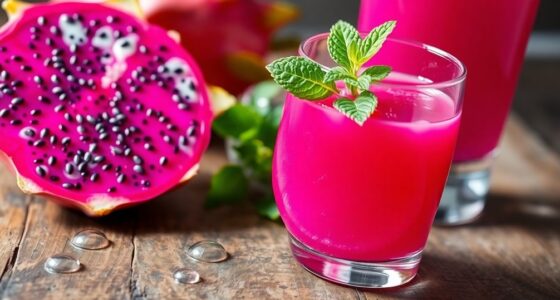To juice ginger without a juicer, start by peeling and chopping fresh ginger root into small pieces. Blend it with filtered water—use one cup of water for every five ounces of ginger—until smooth. Then, strain the mixture through a fine mesh strainer or nut milk bag to extract the juice, pressing on the pulp to get every drop. Store the juice in an airtight container or freeze it for later. There's even more you can do with your ginger juice!
Key Takeaways
- Peel fresh ginger and cut it into 1-inch pieces for easier blending and optimal juice extraction.
- Blend chopped ginger with filtered water (1 cup per 5 ounces of ginger) until smooth.
- Strain the ginger puree using a fine mesh strainer or nut milk bag to separate juice from pulp.
- Press down on the pulp gently to extract maximum juice yield from the ginger.
- Store ginger juice in an airtight container in the fridge for up to a week or freeze in ice cube trays for longer storage.

If you want to enjoy the vibrant flavor and health benefits of ginger juice, juicing it at home is both easy and rewarding. You don't need a fancy juicer to extract fresh ginger juice; all you need are a few simple tools and some fresh ingredients. Let's dive into the straightforward steps you can follow to make your own homemade ginger juice.
Start by gathering your supplies. First, you'll need fresh ginger root, which you can find in most grocery stores. To prepare the ginger, peel it using a spoon or a vegetable peeler. This step is crucial because the skin can be tough and may affect the flavor of your juice. Once you've peeled the ginger, cut it into 1-inch pieces. This will make it easier to blend later on.
Next, it's time to blend. Place the chopped ginger into your blender, adding filtered water. A good ratio is about 1 cup of water for every 5 ounces of ginger. This amount of water will help you create a smooth ginger puree without overwhelming the flavor. Blend on high speed until the mixture is smooth. You want a nice consistency, so don't rush this step. The smoother the mixture, the easier it'll be to extract as much juice as possible.
After blending, it's time to strain the mixture. Take a fine mesh strainer or a nut milk bag and place it over a bowl. Pour the ginger puree into the strainer, allowing the juice to flow through while trapping the ginger pulp. Press down on the pulp gently but firmly to extract as much juice as possible. You might be surprised at how much juice you can get from a small amount of ginger root!
Once you've extracted all the ginger juice, you can store it in an airtight glass container in the refrigerator for up to one week. Alternatively, if you want to enjoy it for a longer period, consider freezing the juice in ice cube trays. This way, you can pop out a cube whenever you need a burst of flavor and health benefits.
For those looking to enhance the flavor of their ginger juice, don't hesitate to add a splash of lemon juice or some coconut water. These optional add-ins can elevate the taste while also boosting the health benefits of your homemade ginger juice. Lemon juice adds a zesty kick, while coconut water offers a subtle sweetness and hydration.
Now that you know how to juice ginger without a juicer, you can easily enjoy the refreshing and invigorating taste of fresh ginger juice at home. With just a little effort, you're set to reap the incredible health benefits ginger has to offer. So, grab your ginger root and get started on this delightful culinary adventure!
Frequently Asked Questions
How Do You Manually Juice Ginger?
To manually juice ginger, start by peeling the root with a spoon or vegetable peeler to avoid bitterness.
Cut the peeled ginger into small chunks, about one inch in size.
Blend these pieces with water—roughly one cup for every five ounces of ginger—until smooth.
Strain the mixture using a fine mesh strainer or nut milk bag, pressing down on the pulp to get all the juice out.
Store the fresh juice in an airtight container.
Can You Blend Ginger Instead of Juicing?
Yes, you can definitely blend ginger instead of juicing it!
Just chop the ginger root into small pieces and blend it with water. Aim for about 5oz of fresh ginger with 1 cup of water, blending until smooth.
After that, strain the mixture through a fine mesh strainer to separate the juice from the pulp. This method retains more fiber, which can be great for your digestive health and keeps the ginger flavor vibrant!
Is It Better to Boil or Juice Ginger?
When you boil ginger, you lose some of its powerful nutrients and antioxidants.
Juicing, on the other hand, preserves those benefits, giving you a concentrated form of its spicy goodness.
While boiling may soften the flavor, juicing keeps it bold and intense.
If you're after maximum health benefits, you'll find fresh ginger juice far more effective than boiled ginger.
How Do You Juice Ginger in a Blender?
To juice ginger in a blender, you'll start by peeling the ginger root, though keeping the skin can add nutrients.
Cut it into 1-inch pieces and blend with about a cup of filtered water until smooth.
After blending, strain the mixture through a fine mesh strainer or nut milk bag, pressing the pulp to extract all the juice.
You can also mix in coconut water or lemon juice for extra flavor!
Conclusion
In the vibrant dance between simplicity and flavor, juicing ginger without a juicer reveals a world of possibilities. You've transformed a humble root into a zesty elixir, embracing both the ease of your kitchen and the boldness of fresh ingredients. While machines promise efficiency, your hands have crafted something uniquely personal. So, as you savor that spicy kick, remember: sometimes the best creations arise not from gadgets, but from your own ingenuity and a dash of determination.
Cindy thoroughly researches juicing trends, techniques, and recipes to provide readers with practical advice and inspiration. Her writing style is accessible, engaging, and designed to make complex concepts easy to understand. Cindy’s dedication to promoting the advantages of juicing shines through her work, empowering readers to make positive changes in their lives through the simple act of juicing.

















